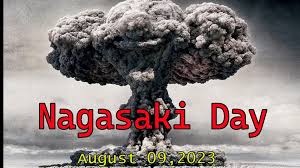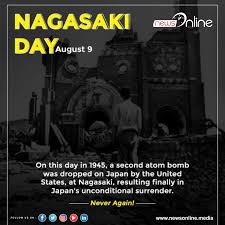Nagasaki Day

Nagasaki Day is celebrated on the 9th of August every year. On this day in the year, 1945 US dropped a second nuclear bomb on this city in Japan. After three days after dropping the first bomb on Hiroshima named ‘Little Boy’.
The Bomb dropped on the city was code-named ‘Fat-Man’ which killed over 80000 people there. Since that time this day is known as Nagasaki day. At least 70000 people died at the initial blast and over 70000 suffered from radiation-related illness.
This led to Japan’s unconditional surrender to America in Second World War. Many survivors of this attack developed cancer and other illness due to their exposure to radiation and suffered discrimination.
Nagasaki Day Quotes and Slogans 
- “Nagasaki isn’t just one international city with fascinating history,
rather it is a global inspiration for all those who seek to create a safer and secure world.”
- “Nuclear bombing on Japan is among the most unspeakable crimes which take no position on the scale of horrors in history.”
- “How do we prevent Iran from developing an atomic bomb on the American side, when nuclear dropping on Japan is not recognized as a war crime.”
- “Now when we look back to Guildford of that time,
it seems much more exotic than Nagasaki.”
- “In Nagasaki, American planes dropped the warning leaflets – but not till Aug 10, the day after the city was bombed.”
- “Nuclear proliferation has never been brought under control, and the nuclear superpowers of the present time carry atomic bombs much more devastating than the ones dropped on Nagasaki.”
- “Now when we look back to Guildford of that time, it seems much more exotic than Nagasaki.”
- “Every positive value has its price in negative terms; the genius of Einstein leads to atomic bombings on Nagasaki.”
- “Anyone who visits Nagasaki can clearly see that they’ve been put in the dark by the United States government about what havoc atomic bombs can create.”
- “This day reminds us of putting peace first; working on conflict prevention and resolution, reconciliation, and dialogue; and tackling the roots of violence.”
Conclusion
9th August 1945 Nagasaki Day was a day of horror for this city and Japan, which showed the world the destructive powers of nuclear weapons.
The use of nuclear weapons can be this dangerous the world saw the cost of Hiroshima and this city. This war ended in Japan’s unconditional surrender to the US and the world hoped for Nuclear Free World.
Historical Background
During the final stages of World War II, the United States dropped two atomic bombs on Japan. The first was on Hiroshima on 6th August 1945, followed by the second on Nagasaki three days later, on 9th August.
The bomb dropped on Nagasaki, nicknamed “Fat Man,” was a plutonium-based nuclear weapon. At 11:02 AM, it exploded over the city, instantly killing tens of thousands of people. Unlike Hiroshima, Nagasaki’s hilly terrain absorbed some of the impact, but the destruction was still catastrophic. By the end of 1945, it is estimated that more than 70,000 lives were lost, with many others dying later due to radiation effects.
Human Suffering and Aftermath
The bombing caused widespread destruction. Houses, factories, and public spaces were reduced to rubble. Survivors, known as hibakusha, suffered from severe burns, radiation sickness, trauma, and long-term health effects such as cancer and birth defects.
The emotional and psychological pain was equally devastating. Families were torn apart, children orphaned, and survivors lived with lifelong scars, both visible and invisible. The scale of human suffering turned Nagasaki into a global symbol of the horrors of nuclear war.
Why Nagasaki Was Targeted
Originally, the bomb was intended for another Japanese city, Kokura. However, due to poor visibility and weather conditions, the target was shifted to Nagasaki. This decision changed the course of history, making Nagasaki the last city in the world to experience the destructive force of a nuclear bomb in war.
Japan’s Surrender and the End of World War II
Just days after the bombings of Hiroshima and Nagasaki, Japan announced its surrender on 15th August 1945, bringing an end to World War II. While debates continue over whether the bombings were necessary, there is no doubt that they pushed Japan toward surrender.
For the people of Japan, the bombings left behind deep wounds. Yet, they also became turning points that reshaped Japan’s national identity, leading the country to adopt a pacifist constitution that renounced war and nuclear weapons.
Global Impact of the Bombing
The bombings of Hiroshima and Nagasaki shocked the world and changed the course of history. They marked the beginning of the nuclear age, where the destructive potential of atomic weapons became a real threat to humanity.
After the war, nuclear weapons development accelerated as nations raced to build their own arsenals. At the same time, peace movements gained momentum, calling for nuclear disarmament and warning against the dangers of another global war. Nagasaki became a voice for peace, reminding the world of the consequences of nuclear conflict.
Observing Nagasaki Day
Every year, on 9th August, memorial services are held in Nagasaki, particularly at the Nagasaki Peace Park and the Atomic Bomb Museum. Survivors share their stories, leaders pledge for peace, and the world reflects on the tragedy.
The ceremonies often include:
-
Moments of silence at 11:02 AM, the exact time the bomb was dropped.
-
Peace declarations by city officials and activists.
-
Prayer services and cultural events dedicated to victims.
-
Educational programs for younger generations to understand the importance of peace and nuclear disarmament.
Lessons from Nagasaki Day
Nagasaki Day is not just about remembering the past—it is about learning from it. The tragedy teaches the world several lessons:
-
The Devastation of War – No country truly wins when human lives are lost on such a massive scale.
-
Nuclear Disarmament – The need for a world free of nuclear weapons remains urgent.
-
Human Resilience – Survivors of Nagasaki inspire the world with their courage and commitment to peace.
-
Global Unity – War and violence affect all of humanity, making international cooperation for peace essential.
Relevance in Today’s World
Even today, Nagasaki Day holds critical importance. The threat of nuclear weapons has not disappeared. Countries continue to maintain and upgrade nuclear arsenals, while global conflicts raise fears of nuclear escalation.
At the same time, peace organizations, governments, and the United Nations continue to push for treaties and agreements such as the Treaty on the Prohibition of Nuclear Weapons (TPNW). Nagasaki’s voice continues to remind the world that nuclear war is not an option for humanity’s future.
Inspiring Generations for Peace
Nagasaki Day encourages education and awareness, especially among younger generations. Schools, colleges, and organizations worldwide use this day to discuss the dangers of war and the importance of peace. By sharing survivor stories and promoting cultural exchanges, societies build empathy and responsibility toward creating a peaceful world.
Conclusion
Nagasaki Day is more than a commemoration of a tragic past—it is a call to action. The bombing of Nagasaki was one of the darkest chapters in human history, yet it gave rise to a global movement for peace and disarmament.
As we honor the victims and remember their suffering, we must also carry forward the message of peace. The lesson from Nagasaki is clear: humanity must work together to ensure that nuclear weapons are never used again.
On every 9th August, let us not only mourn the past but also pledge for a future where peace prevails over war, compassion over hatred, and humanity over destruction.https://yesnearme.com/news/luxurious-5-star-hotels-in-nagpur/
‘
